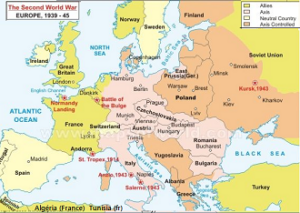
Arquivo para February 17th, 2022
Hate and Intolerance in History
It is necessary to know the historical process to understand the bases on which a world polarization and an alleged new world order, a very vague term and subject to many interpretations, which led to polarization in the period of the Cold War and which seems to return with new molds, where the leaven of hate can flourish.
the bases on which a world polarization and an alleged new world order, a very vague term and subject to many interpretations, which led to polarization in the period of the Cold War and which seems to return with new molds, where the leaven of hate can flourish.
The reasons that led to the formation of the Axis, an alliance with the Nazis in World War II, were: territorial expansion with the creation of empires based on military conquests and the overthrow of the post-First World War international order, and the destruction and neutralization of Soviet communism.
Germany and Italy signed 1st. November 1936, a week after announcing a friendship pact, the creation of the Rome-Berlin Axis and then on November 25, 1936 the Anti-International Communist Pact (Comintern) in opposition to the Soviet Union, Hungary, Bulgaria and Slovakia joined the Axis in November 1940, later Croatia joined, Finland joined the USSR in 1941 and in April of that year Yugoslavia was invaded and dismembered by Axis forces and then the Soviet Union.
At the beginning of the war, in 1st. From September 1939, the allies were France, Poland and the United Kingdom, as well as the states dependent on the British Crown: India, Australia, Canada, New Zealand and South Africa, after the invasion of Belgium, in addition to the Netherlands and Greece joined the allies, the Soviet Union supported the invasion of Poland, but realizing that it would be betrayed by the Nazis, it also became an ally, the United States would fully enter the War after the attack on Pearl Harbor (7 December 1941 ), supported with money and weapons until then, in December 1941 it became an allied member with troops and sending heavy weapons to Europe.
China has had a protracted war with Japan since the Marco Polo Bridge Incident in 1937, which was an incident of the disappearance of a soldier and troops stationed on either side of this bridge that is close to Manchuria (the disputed region), so China officially joined the Allies in 1941.
With the Axis practically defeated, the Tehran Conference was held with the first territorial divisions of the occupation troops in each country, this is important to understand the Soviet advances constituting Eastern Europe, the D-Day of the disembarkation of the troops in Europe was held in December 7, 1941.
The Potsdam and Yalta conferences were held on July 17 and August 2, 1945, respectively, before the bombing of Nagasaki and Hiroshima on August 6 and 9.
Two attitudes must be analyzed in the post-war agreements, one is the reintegration of German territory to the war in the limits before the first war, with the exception that the place where the former Königsberg was after Stalingrad and today Kaliningrad was taken by the USSR and the Germans. were expelled, the negative was the nuclear bomb on Nagasaki and Hiroshima when the war was practically over, and the effects of the bomb marked the history of mankind forever, dropped in August 1945.
In the next post, we will analyze the advance and the almost end of the cold war and what can cause an imbalance and create a New World Order, an acronym used in different ways.

